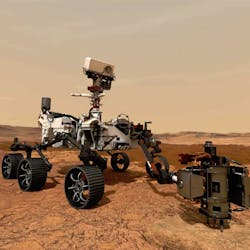Ion beam sputtered low loss optical coatings and space-qualified cavity optics specialist MLD Technologies, LLC, (Mountain View, CA) developed specialized mirrors, output couplers and windows for the Photon Systems’ 248.6 nm neon copper (NeCu) laser used to power the deep UV Raman and fluorescence spectral mapping instrument aboard the Perseverance Rover, which landed on Mars February 18, 2021. The companies cavity optics are optimized for low absorption, scatter, and fluorescence and were manufactured using specially designed coatings and processes to enable the narrow line-width deep UV (DUV) laser made by Photon Systems that is the heart of the Scanning Habitable Environments with Raman & Luminescence for Organics and Chemicals (SHERLOC)instrument.
The cavity optics enable the Photon Systems Neon Copper pulsed laser, making non-contact detection and characterization of organics and minerals on the surface of Mars possible. The reflectors in this TRL-9-tested DUV gas laser generate the necessary feedback for stimulated emission at the lasing wavelength of 248.6 nm while diminishing lasing at nearby wavelengths. Excitation is maximized at the single wavelength of interest while allowing the much weaker Raman signals to be detected more distinctly, without fluorescence interference or obscuration. The Photon Systems DUV laser, as the active illuminator for the experimental functions of SHERLOC, provides energy for DUV induced native fluorescence and resonance Raman emissions from organics and minerals and provide spatial context to organics in a mineral matrix.
SHERLOC operates at the end of the rover’s robotic arm, where the DUV laser empowers the two types of UV light spectroscopy, each requiring a distinct detection capability. Luther Beegle, principal scientist and investigator at NASA Jet Propulsion Laboratory, reports, “It can detect an important class of carbon molecules with high sensitivity, and it also identifies minerals that provide information about ancient aqueous environments.”
MLD Technologies' Linda Lingg, remarks, “MLD is proud to contribute to this groundbreaking mission by developing the specialized DUV cavity optics for the Photon Systems NeCu laser, which will enable the quest for habitability on Mars via the Perseverance Rover’s SHERLOC imager.”
